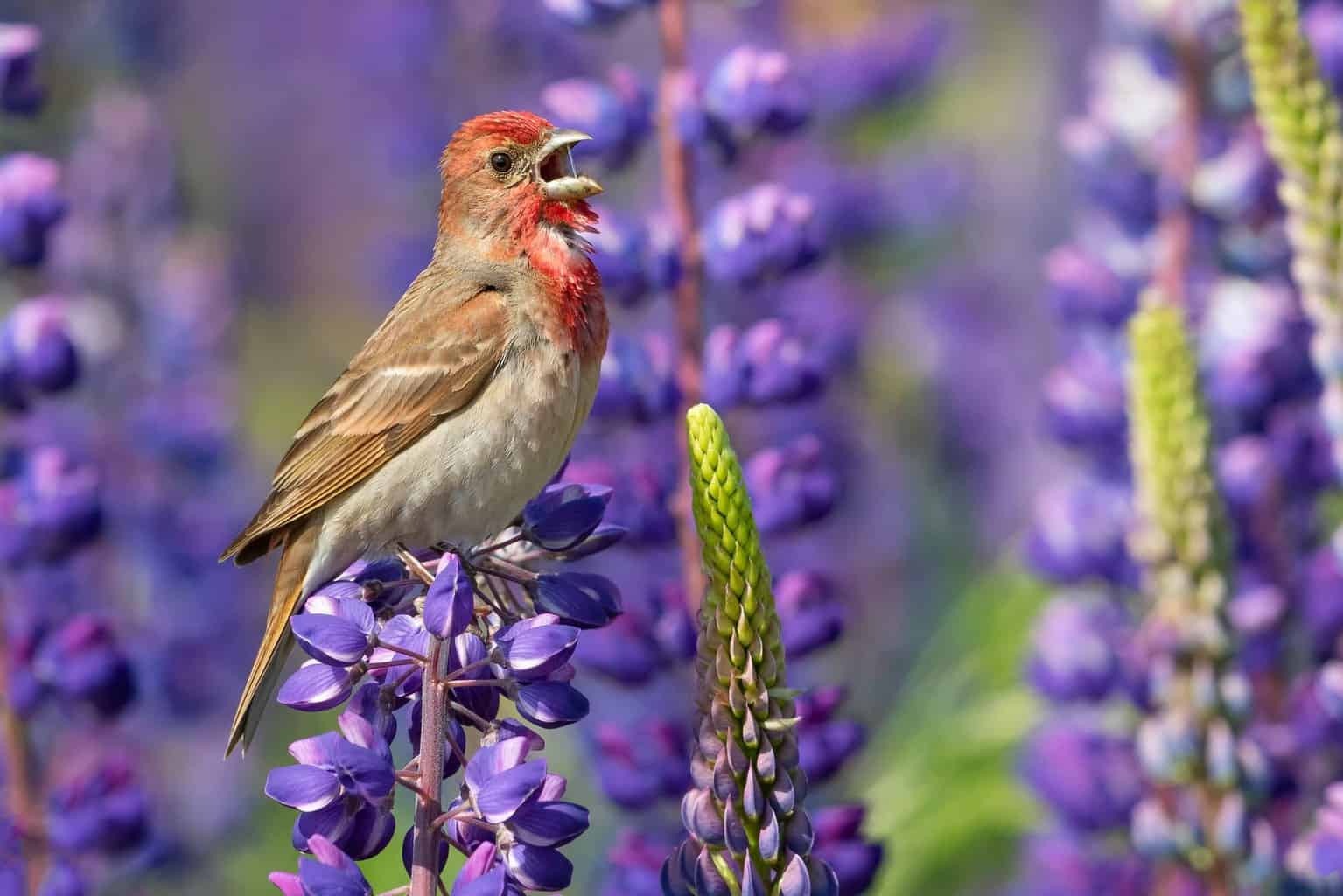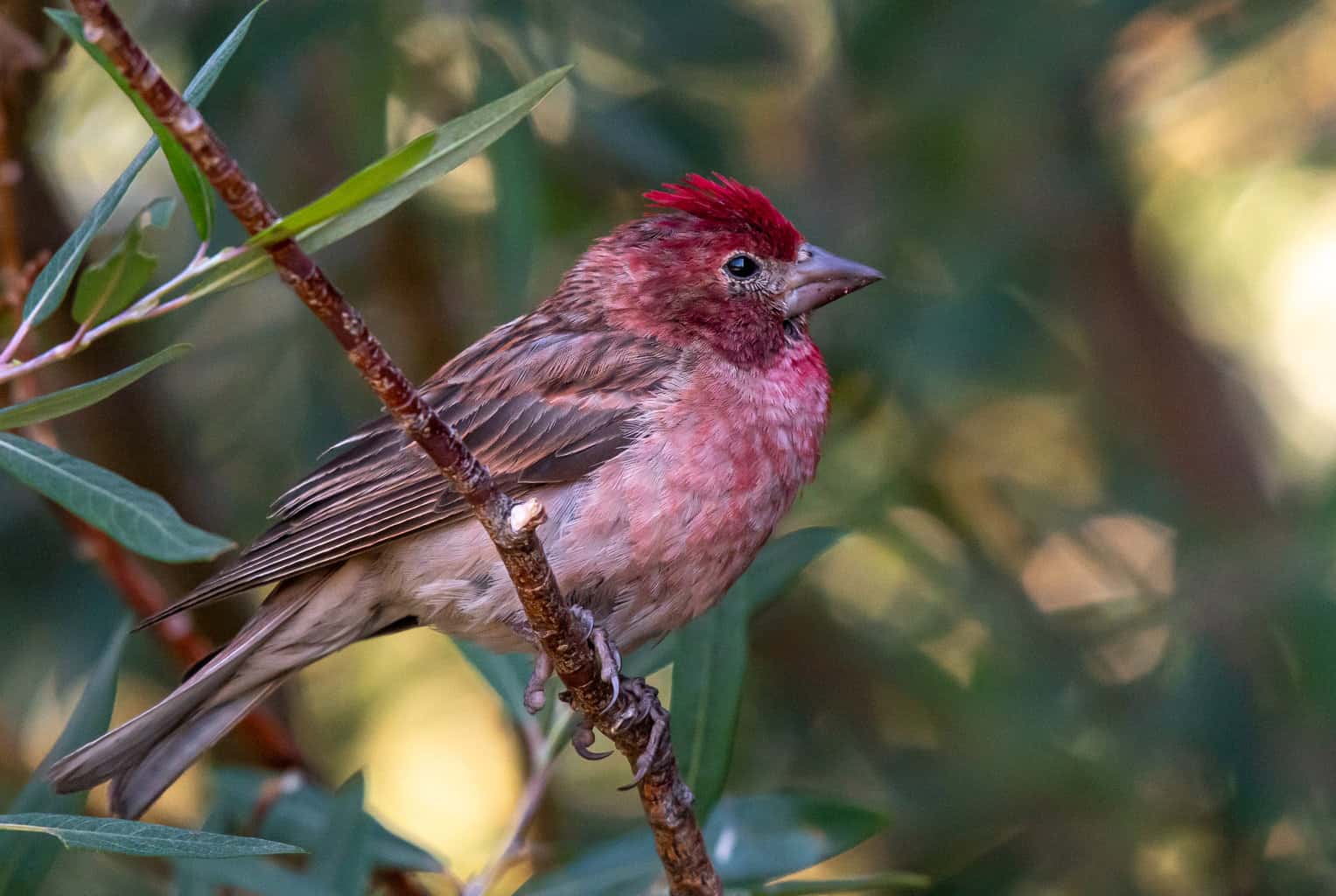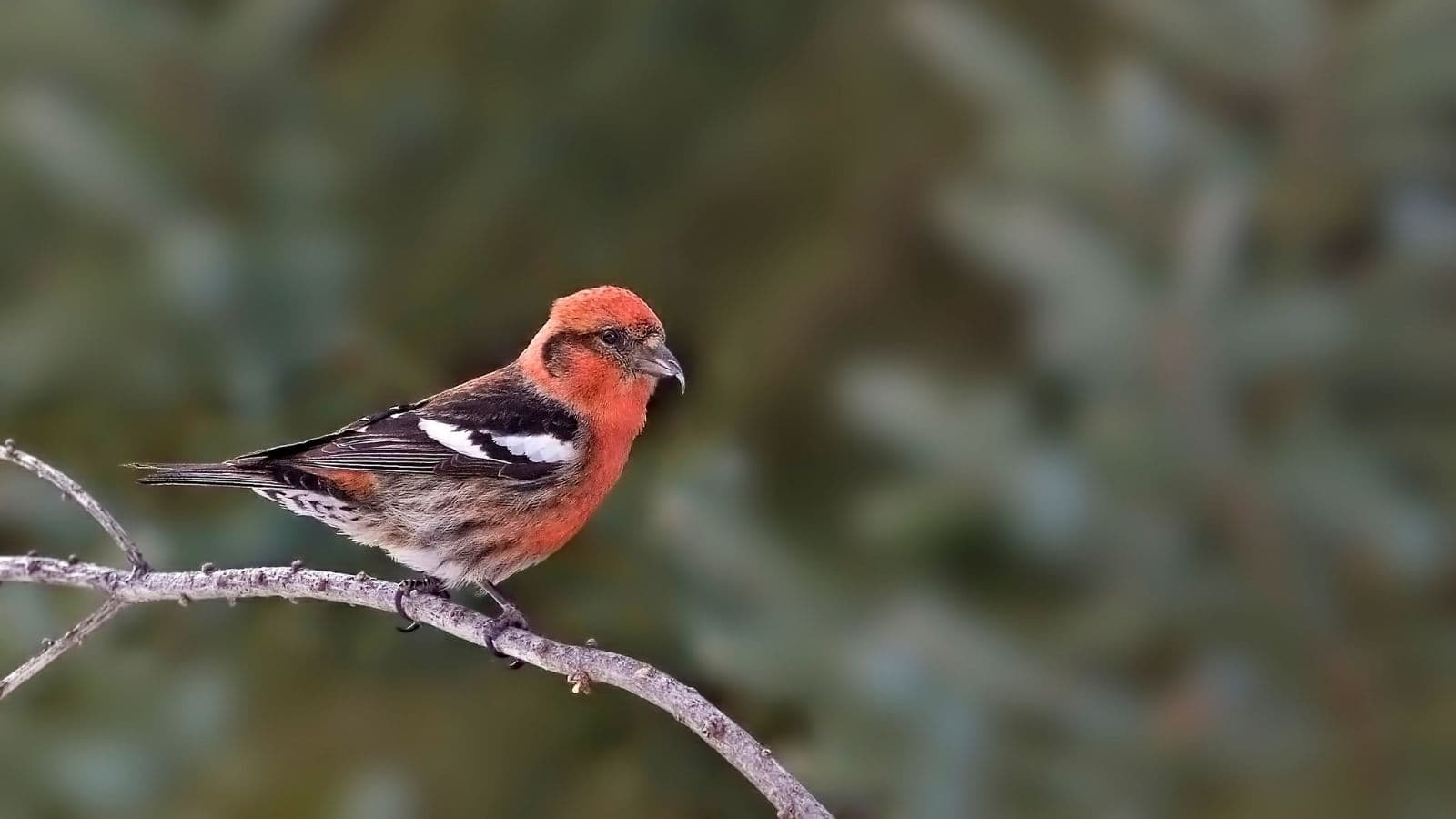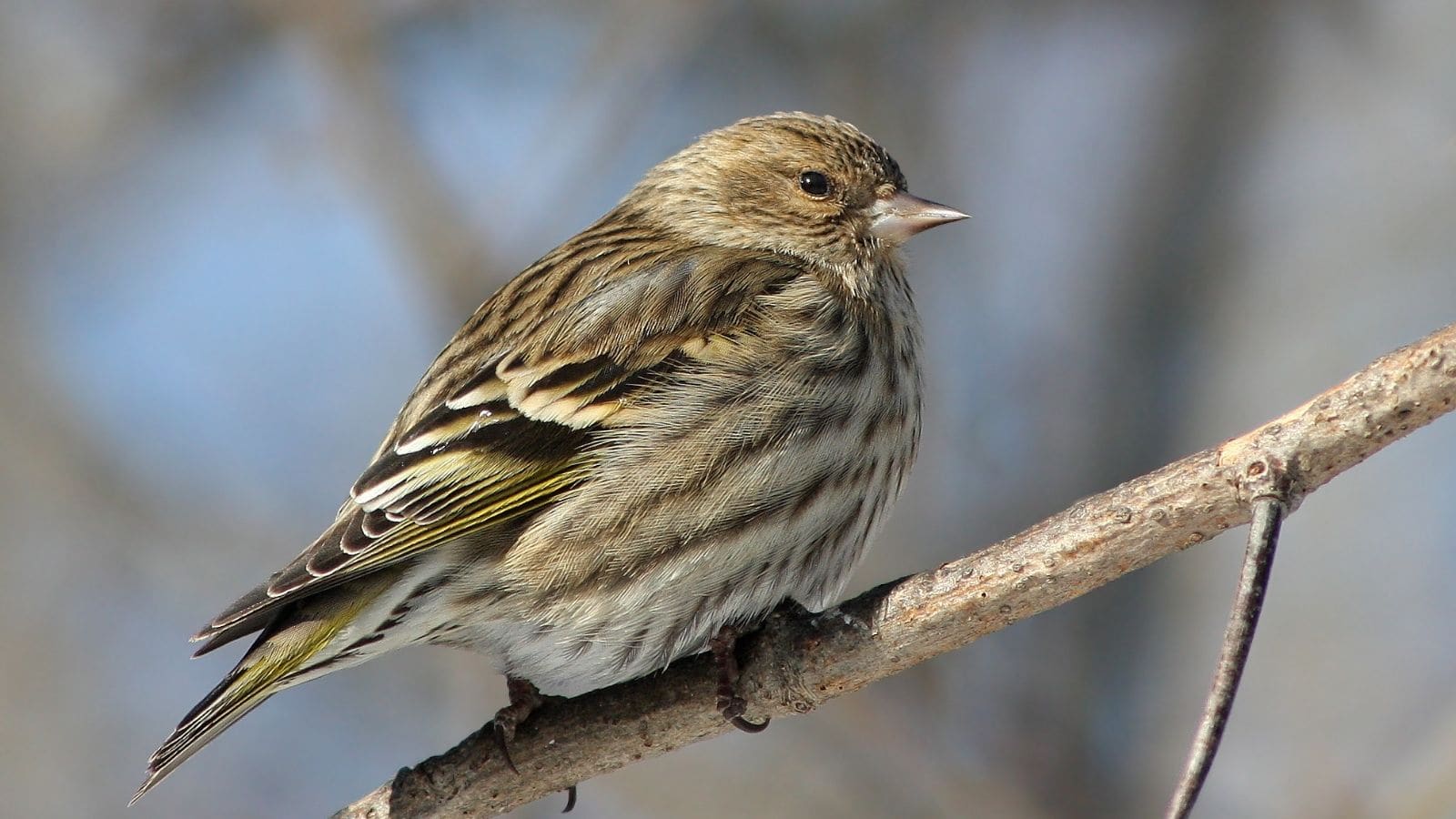It’s known as the land of the Shining Mountains and its avian mascot is the Western meadowlark, a beautiful bird whose throat and breast are covered in a vivid yellow and a black mark reminiscent of a necktie.
Montana is also home to the bullock’s oriole, known for the yolk-yellow plumage of its males against which black wings edged with pristine white stand out, creating a striking visual effect.
It is also home to many more forms of avian wildlife. There are 442 bird species in Montana, 15 of which are finches.
They are all presented here in a nutshell so you can absorb their key points with a minimum of fuss and get to understand these clever, colorful passerines a little better.
Brambling

- Scientific Name: Fringilla montifringilla
- Length: 6 inches
- Weight: 0.8 – 1.02 ounces
- Wingspan: 10 inches
Bramblings are pretty hard to miss with their beautifully patterned plumage which starts out dark at their heads before morphing into orange at the chest then white at their abdomen.
Those black wings with white wing bars provide a striking contrast making them all the more noticeable.
These medium-sized finches, which are often mistaken for chaffinches, are occasional visitors to Alaska. However, they rarely make it as far south as Montana and are very rarely seen in the state, as a result.
Evening Grosbeak

- Scientific Name: Hesperiphona vespertina
- Length: 6 – 9 inches
- Weight: 1.4 – 3 ounces
- Wingspan: 12 – 14 inches
Their size makes them pretty hard to miss and if they’re male, their coloring too means they will stand out at that bird feeder or on that box elder branch.
Evening grosbeaks are rather large compared to their other relatives and males are boldly colored in brown, mustard, black, and white.
They also have a thick yellow stripe above their eyes which contrasts with the dark brown of their head feathers. Their black wings with bold white centers further enhance the contrast with those colors and the mustard of their upper and under surfaces.
Female evening grosbeaks on the other hand are less striking in terms of colors and contrasts being covered in a mild gray with a touch of yellow at their throats.
Evening grosbeaks can be found in western Montana all year round. They may also venture eastwards. These sturdily built finches also live all year round in neighboring Idaho, Washington, and Oregon.
Pine Grosbeak

- Scientific Name: Pinicola enucleator
- Length: 9 inches
- Weight: 2 – 3 ounces
- Wingspan: 13 inches
As is the case with several bird species, the colors of both male and female pine grosbeaks are remarkably different.
Females are covered in a muted gray with hints of bronze at their rumps and their heads. Males, however, are covered in a bold red. Both genders have dark brown wings and tails, as well as a bold beak for tackling large seeds.
Pine grosbeaks can be found in western Montana all year round. They can also be found in Idaho, Washington, Oregon, and the western and southwestern United States.
Gray-Crowned Rosy-Finch

- Scientific Name: Leucosticte tephrocotis
- Length: 5.5 – 6.3 inches
- Weight: 0.8 – 2 ounces
- Wingspan: 13 inches
In keeping with its name, this finch is gray at the head with a black mask. The rest of its plumage, however, is a dark brown. There are hints of pink as well as gray on its wings and its long, forked tail.
Like the black rosy-finch, it is at home in the tundra. It is equally at ease in mountainous regions, too.
The gray-crowned rosy-finch can be found in northwestern Montana all year round. During winter it spreads to the rest of the state with the exception of its extreme northeast. This species can also be found in Idaho, Washington, Oregon, and California.
Black Rosy-Finch

- Scientific Name: Leucosticte atrata
- Length: 6.5 inches
- Weight: 2 – 3 ounces
- Wingspan: 13 inches
Unlike the gray-crowned rosy-finch, whose head is completely gray, only the upper half of the black rosy-finch’s head is gray. In place of the mask of its gray-crowned counterpart, this rosy-finch has a black forehead. The rest of its body is covered in the same dark brown although its wing feathers are pale with a light blush of pink, which can also be found on those covering its abdomen.
The black rosy-finch lives in southwest Montana all year long. However, it spreads slightly eastward in winter.
The species can also be found in northeastern Idaho, southeastern Oregon, northeastern Nevada, and northeastern Utah all year long, and may expand outwards during winter in a range that may include Colorado, New Mexico, and possibly Arizona.
House Finch

- Scientific Name: Haemorhous mexicanus
- Length: 5 – 6 inches
- Weight: 0.6 – 0.9 ounces
- Wingspan: 8 – 10 inches
House finches are covered in brown plumage with blurred streaks at their chest, flanks, and abdomen. Male house finches are also covered with red blush on the face and chest. It is worth noting that this hue is different from the pink/purple shade found in purple finches.
In place of red, male house finches may also be covered in orange or yellow instead.
House finches are found throughout Montana all year long. Due to having spread from their native range in the western United States to the east in the 1940s, they can be found in every state in North America.
Purple Finch

- Scientific Name: Haemorhous purpureus
- Length: 4.7 – 6.3 inches
- Weight: 0.63 – 1.10 ounces
- Wingspan: 10 inches
Male members of this species are brown in color with striated patterns at their chests and flanks.
Their heads, chests, and occasionally upper surfaces are covered in a red blush which has hints of purple and pink. The color of that pigment is almost always the same in purple finches. The occurrence of orange or yellow coloring in them is extremely rare.
The streaked patterns on female purple finches are rather defined and bold in a dark brown and stand out against a paler surface at the chest. Females also have white stripes above their eyes.
Purple finches also have short forked tails, rounded heads, and tubby forms.
Members of these species may only pass through Montana when migrating. As a result, sightings of these rose finches are few and far between, numbering about eight annually.
Purple finches can be found all year round on the Pacific Coast. They migrate east during winter in a range that starts from Southern Dakota and extends all the way to the Atlantic Coast.
Permanent populations can also be found in Maine, Vermont, New Hampshire, Connecticut, Massachusetts, New York, Pennsylvania, and West Virginia.
Cassin’s Finch

- Scientific Name: Haemorhous cassinii
- Length: 6 inches
- Weight: 0.8 – 1.2 ounces
- Wingspan: 10 – 11 inches
These relatives of house finches and purple finches can be recognized by their beaks, which are longer and tapered compared to those of other rose finches.
Males sport a red tuft at the crown and a flush of pink at the face and upper chest.
Their undersurfaces are plain white. Females, however, lack the red coloring of their male counterparts and are heavily striated at the breast and undersurfaces. Their coloring is brown overall.
Cassin’s finches live all year round in western Montana. Their range extends throughout the western and southwestern United States. These passerines also breed in British Columbia in neighboring Canada, and head to Mexico during winter.
Common Redpoll

- Scientific Name: Acanthis flammea
- Length: 4.5 – 5.5 inches
- Weight: 1.12 ounces
- Wingspan: 8 – 9 inches
These seemingly cold-resistant passerines have brown wings, as well as streaks on their heads, chests, and flanks. As a result, they appear to be predominantly white and brown.
They also have a dark red patch at the crown as well as a flush of pink at the chest.
Common redpolls can be found in Montana’s extreme northeast during winter. They may also be found in other parts of the state during the season. Their main wintering range, however, lies further north comprising northern Minnesota, North Dakota, and southern and central Canada.
Hoary Redpoll

- Scientific Name: Acanthis hornemanni
- Length: 5 – 5.5 inches
- Weight: 0.40 – 0.50 ounces
- Wingspan: 8 – 10 inches
Although common redpolls are covered in plumage in dark shades of brown with hints of white, hoary redpolls are paler with plumage that is not as heavily streaked.
That said, they have the same compact form as well as that signature scarlet patch at the crown. Their wings are also similar and are covered in dark brown feathers edged with white.
Hoary redpolls winter in Alaska as well as Canada, however, they may also move further southwards down into the United States. During such winters, they may be found in northeastern Montana.
Red Crossbill

- Scientific Name: Loxia curvirostra
- Length: 7.5 inches
- Weight: 2 ounces
- Wingspan: 12 inches
Males of this species are covered in copper-colored feathers which morph to brown at their wings and tails. They also have dark beaks which are crossed at the tips.
In place of the reddish coloring found in males, females are olive. They too share the same dark wing and tails as their counterparts.
Nesting season for this species is dependent on the availability of pine cones in abundance.
Red crossbills’ range extends from southern Alaska, Yukon, and the Northwest Territories to British Columbia in its entirety, all the way to New Brunswick.
It also extends southwards into the western and southwestern United States, right through to Mexico. As a result, these small avians can be found in western Montana all year round.
White-Winged Crossbill

- Scientific Name: Loxia leucoptera
- Length: 5.7 – 6.7 inches
- Weight: 0.9 – 1.40 ounces
- Wingspan: 11 inches
This species derives its name from the white wing bars which stand out against black feathers, creating quite a contrast.
It is an effect that is especially highlighted against the red plumage of males. Females of the species are however colored gray and bronze.
As their name suggests, both genders also share that characteristic bill which is crossed at the tips with which they open cones when feeding.
Because the range of this species lies further to the north and is not as extensive compared to red crossbills’, they are rarely found in Montana. However, they may fly south during winter in which case they may be found in the state.
Pine Siskin

- Scientific Name: Spinus pinus
- Length: 4 – 5.5 inches
- Weight: 0.40 – 0.60 ounces
- Wingspan: 7 – 9 inches
The plumage of this species which is considered to be somewhat similar in behavior to goldfinches is patterned with streaks of varying shades of brown. Those at their heads and backs are denser while those at their breasts and undersurfaces are bolder thanks to their lighter background. Hints of yellow can also be found on the tails and wings of these passerines.
Pine siskins can be found in the western United States and even in Mexico in the south. They can also be found in western Montana all year round.
During irruption years, their winter range extends eastwards from Montana in the north to New Mexico in the south and eastwards to the Atlantic Coast.
Lesser Goldfinch

- Scientific Name: Spinus psaltria
- Length: 3.5 – 5 inches
- Weight: 0.3 – 0.4 ounces
- Wingspan: 6 – 8 inches
Male lesser goldfinches are a bold citrus yellow at their undersurfaces and their chests, and black or olive at their upper surfaces including their heads. They also have a black cap at the crown.
Their wings are dark with feathers that fade to white at their edges.
Female members of the species have the same coloring and patterns on their wings, however, their heads are covered in a mild brown which extends to the nape. Their under surfaces are a more subdued shade of yellow compared to the color present in males
Lesser goldfinches are rarely found in Montana. This is due to the fact that their range lies far to the south and to the west of the state. The species breeds in Nevada, Utah, Colorado, Arizona, and New Mexico, and can be found all year round along the Pacific Coast from central Oregon.
These finches also live throughout the year in southeastern Arizona, southern New Mexico, and southwestern Texas.
American Goldfinch

- Scientific Name: Spinus tristis
- Length: 5.5 inches
- Weight: 0.4 – 0.7 ounces
- Wingspan: 8 – 9 inches
A glance at a male American goldfinch during breeding season will reveal just how beautiful this species is with an abundance of citrus yellow and a striking black cap. Wings that come together in a startling contrast of black marbled with white further highlight the beauty of its plumage. A conical golden beak also complements that same summery hue.
Females on the other hand are somewhat less striking with their straw-colored plumage and tapering gray bills.
American goldfinches breed throughout most of Montana. They are however permanent residents in its western and southeastern regions.
North Dakota and Minnesota’s northern regions also form a part of the species’ breeding range which extends northwards throughout southern Canada.
Conclusion
If you live in Montana, you will have the opportunity to not only catch a glimpse of several finches but to also view a few often rarely admired elsewhere.
Included in that selection are the common redpoll during winter, Cassin’s finches all year round, as well as migratory purple finches.
Also included are black and gray-crowned rosy-finches, as well as pine and evening grosbeaks.
What’s more the fact that you would also be able to view more ubiquitous finch species such as house finches and American goldfinches is simply the icing on the cake.

